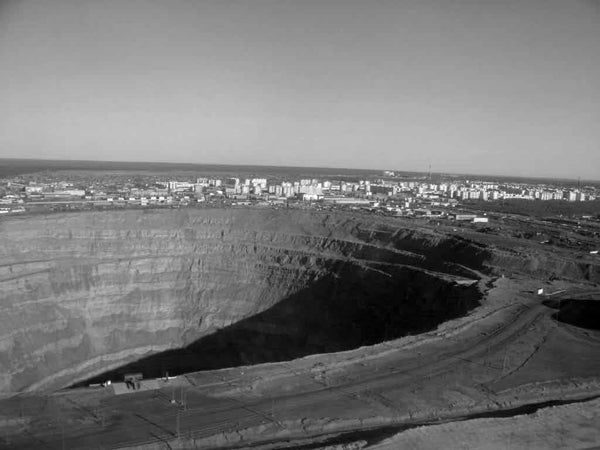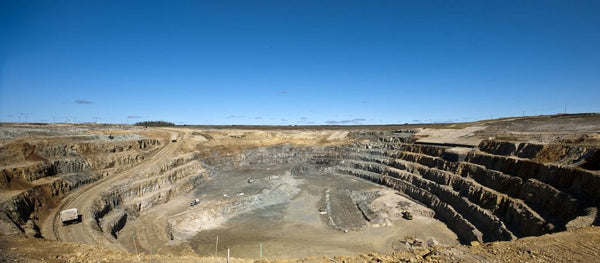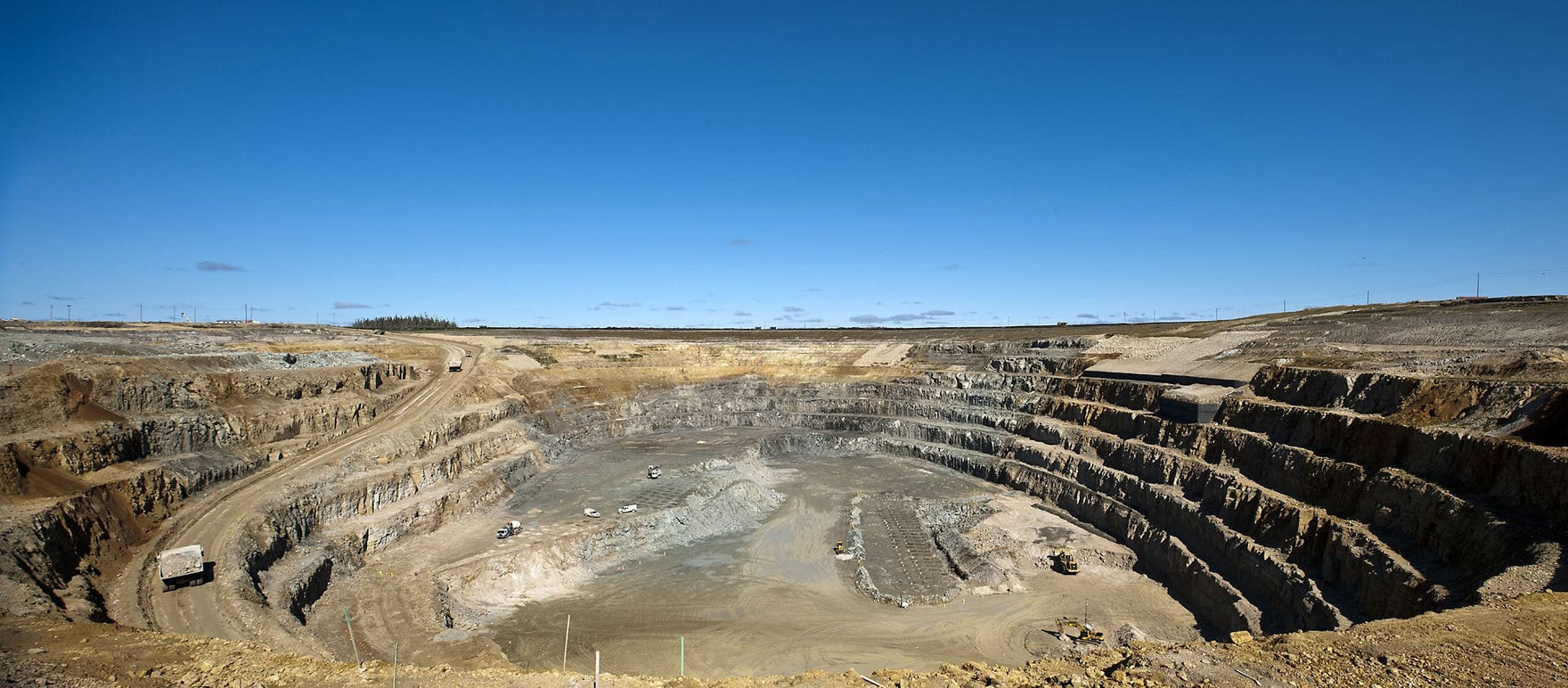The sad history of diamond mining awareness plays out on many levels. In large scale mechanised mining, there is often little regard for the environment.
Consumers are led to believe that there is a certain romance in wearing a diamond that has grown in the belly of the Earth for millions of years.
There's no romance in a stone that has been pulled from the Earth causing irreversible damage to delicate eco-systems and environments or with potential human harm. It's a contradiction. Any gift of love from the heart should not result in such irreversible damage.
The danger to biodiversity begins when roads are built for purposes of exploration and land is cleared for settlement. These operations are also terribly destructive both to the land and to adjacent aquatic ecosystems. And all too often, the spoils of the process continue to poison the environment long after commercial operations have ceased.
When a diamond mine is exhausted, the procedures for closing the mine are unregulated and little infrastructure is in place to restore the ecosystem. The extracted material is not always replaced or not replaced adequately, leaving the former ecosystem unable to restore itself. This often results in water pollution, leaving the land unsuitable for farming other uses, susceptible to severe erosion and flooding. The remains of many diamond mines are so enormous that they can be clearly seen from space.
Open Pit & Underground Mines
Diamonds occur naturally deep inside the earth. They are carried to the earth’s surface through Kimberlite Pipes. Kimberlite Pipes are the channels formed from the cooled volcanic activity. The two most common types of diamond mines are open pit (strip mines), and underground mines. All the sand and soil must first be removed to reach the diamond bearing Kimberlite. In some cases, this may involve removing entire lakes and ecosystems. Many tons of material are removed and processed each day using large machinery and explosives. This material is removed using a water intensive extraction method; the resultant waste disposal causes further disruption nearby land that is often larger than the pit itself.
Alluvial Mines
Diamonds also accumulate in rivers and lakebeds over thousands of years as a result of sediment and erosion moving from their original Kimberlite Pipes. These operations scrape away 3.3 million cubic yards of soil and plant life per day and large walls are built to divert the natural flow of water.
Environmental Havoc
Lacking strong controls and regulation, diamond mining has wreaked environmental havoc throughout many parts of the world. Ninety years of environmental neglect in Angola have devastated large tracts of land, poisoned local water, forced indigenous populations to relocate, and removed their primary livelihood. Kono, in the heart of the diamond-mining region in Sierra Leone has experienced a complete loss of rich agricultural soil and farming fields to mining debris. The land is now scarred with thousands of abandoned mining pits filled with mosquito-infested water. In short, mining without much of an awareness of issues related to the environment can result in drastic and permanent changes in the mining areas.
The Navel Of The Earth

The largest manmade hole, the Mir Mine, popularly called the Mirny Mine, is a formerly active open-pit diamond mine located in Mirny, Eastern Siberia, Russia, that at its operational peak produced over 10 million carats of diamonds per year were excavated before the mine was exhausted, then abandoned. Mirny Diamond Mine, Russia holds the fourth position for depth among the world’s open pit mines. Some people also refer to this mine as the Navel of the Earth. With a depth of about 1,722 ft (525 metres) and a diameter of about 3,900 feet (1.25km) the Mirny Diamond Mine holds the fourth position for depth among the world’s open pit mines. The Mirny mine also holds the title of the second largest largest excavated hole in the world. The airspace over this mine is closed for flying because there have been reported incidents of helicopters being sucked in by the airflow. This phenomenon occurs because the size of the Mirny diamond mine often causes the nearby atmosphere to have drastically different temperatures and current flows.
So What About a Canadian Diamond?
It is claimed that Canadian Diamonds are ethically sourced and will advocate the CanadaMark but Canadian Diamonds are not an ethical choice, rather than a pricey misconception labelled as sustainable. Although they aren’t as tarnished as blood diamonds, they are still in conflict with the environment, the ecology and the communities within the mining areas in Canada.
Diamond-rich areas weren't discovered in Canada until the early 1990s. Before that time, diamond mining in Canada had been essentially non-existent. However, within 10 years of their discovery, major diamond mines were unearthed and active mining began. Canada is now currently the 3rd largest diamond producing country in the world. Canadian diamonds are well known for their "guaranteed conflict-free” origins.
Except, diamond mining, or any sort of mining is not sustainable. You dig a hole, you take stuff out of the hole, and take it somewhere else. Eventually, the hole runs out of the stuff you were digging up. That is not sustainable.
Jewellers refer to the 4 C's of a diamond. That is, its colour, cut, clarity, and carat. They all combine to determine the price of a diamond. However, there is another C marketed by some unscrupulous companies as "conflict free" and/or Canadian diamonds. They are in effect attempting to place themselves on a higher moral ground.
The moral bankruptcy of the diamond industry is illustrated very clearly in Canadian diamonds. The poor environmental history of their mines, which operate in ecologically sensitive areas, speaks volumes. Yet the producers and retailers of Canadian diamonds falsely sing in unison about their superior provenance.
MiningWatch Canada is a pan-Canadian initiative supported by environmental, social justice, Aboriginal and labour organisations from across the country. It addresses the urgent need for a co-ordinated public interest response to the threats to public health, water and air quality, fish and wildlife habitat and community interests posed by irresponsible mineral policies and practices in Canada and around the world. Independent MiningWatch Canada has openly reported its observations, damning the Canadian diamond industry.
Environmental Watchdog: De Beers Not Monitoring Contamination at Victor Mine
A report released in 2015 by the Canadian Parks and Wilderness Society's (CPAWS) Wildlands League alleged that neither De Beers nor the national government could monitor mercury risks from the Victor Diamond mine in northern Ontario. The study titled "Nothing to See Here" was the result of an investigation carried out by the environmental group for 18 months and calls for environmental monitoring of the mine. The investigation found failures in self-monitoring and increased concerns about entrusting the company to protect the environment in which it operates. CPAWS Wildlands League policy and research director Trevor Hesselink said: "De Beers has failed to report on five out of nine surface water monitoring stations, a mandatory requirement of its permit, for the last seven years. "To compound matters, it is the downstream mercury samples that are not being reported."
De Beers denied the allegations and stated that its environmental data is often misrepresented. De Beers spokesperson Tom Ormsby told CBC News that the company collects data from 200 ground wells and 15 surface wells and submits it to the government. Ormsby said: "Some sample sites that were relevant in the past may no longer be the most relevant or material now as the mine moved from construction to operations." The Victor mine opened in 2008 and finally closed in May 2019. The Victor mine finally closed in May 2019

Demand Keeps Rising, But What About Sustainability?
The demand for diamonds continues to rise and although diamond mining in the Arctic is a great way to boost Canada's economy, there are too many environmental issues associated with the process. The large companies who are creating more mines are creating increasing levels of ground level ozone which potentially spreads across Canada. Habitats and food supplies of many endangered species are being destroyed, while the isolated Aboriginal groups are running out of food. The manufacturing processes involved with the creation of man-made/lab-grown diamonds do not require harmful pollutants or materials as open pit mining for natural diamonds does. As technology improves, so does the quality of man-made/lab-grown diamonds which can easily replace natural diamonds terms of their hardness & variety. The upper level ozone needs to be protected and as the risk increases of ground level ozone thickening, man-made/ lab-grown diamonds are the way to go.The Negative Impact On The Environment
There are many negative effects from the lack of diamond mining awareness issues with open pit mining especially in Northern Canada.
These include:
- Bad air quality and noise vibrations which scare animals away. Caribou (wild reindeer) bears and fish would lose their habitats and die off because of the huge area these mine sites cover.
- The Ekati diamond mine alone needed 40kg of building materials, machinery, diesel and food, which are all moved by giant trucks along the 475km Inog ice road from Yellowknife which leads into the Ekati mine.
- The environmental footprint was 1400 hectares of land, just for the Ekati open pit mine.
- When water bodies get drained, all of the fish and other creatures living there are killed.
- When the kimberlite rock gets processed, chemicals that are dangerous to water fleas are present, and if the fleas die off, the whole food chain of the Arctic gets disturbed.
- Loss of land-based habitat for wildlife such as caribou, grizzly bears, and wolverine. For instance, radio-collared cows from the Bathurst caribou herd spend 7-8% less time feeding in close proximity to the Ekati mine. The caribou migrate through the mining area, but the huge amounts of dust contaminate the lichen which the caribou eat. Also, the other vegetation which the caribou eat get wiped out because of excavating the mines. The population of caribou declined from 400,000 to 128,000 between the 1980's and 2006.
- Loss of fish habitat through draining of lakes, destruction of streams, changes in water quality. Water quality changes are measurable as far as 200 km downstream of Lac de Gras (Ekati mine), and there have been irreversible changes to water quality and possibly species composition in Snap Lake (De Beers diamond project). Twenty lakes have been eliminated altogether, with no fish habitat compensation measures in place.
- Diamond mining companies insert large amounts of ammonia under the lake beds to help extract minerals. This harms the fish that live there. These toxic chemicals pollute the air in the area and also contaminate surrounding lakes. These toxic chemicals from the mines may also end up in Yellowknife or neighbouring communities due to wind carrying the pollutants.
- When an open pit mine closes down, it usually becomes a landfill, but this would be unsafe for the ecosystem (burrowing animals, chemicals, etc.)
- Soil degrades meaning that no plants would grow in the surrounding area.
- Dust particles created by the open-pit mines contribute to ground level ozone. This is a gas pollutant created by the emissions from industrial facilities, motor vehicle exhaust, gas vapour, etc. This ozone os harmful to inhale because it causes lung problems, throat pain and asthma. In addition, it can also damage crops, trees, vegetation growth. Grown level ozone spreads through large areas, affecting communities miles away from the source due to the effects of the wind.
- Machinery used in open-pit mines runs on chemicals that can destroy or weaken upper ozone layer in those areas, which cause carcinogenic radiation, and damages crops. Humans are causing higher levels of co2, meaning more greenhouse gases and a warmer temperature. The depletion of the upper level ozone in the Arctic would cause UV rays to melt the snow even faster.
- Increased production of greenhouse gases. Both Ekati and Diavik diamond mines are currently fuelled by millions of litres of diesel. Each mine makes a significant contribution to the greenhouse gas produced by the Territories every year.
- Social and cultural impacts from the two existing diamond mines are also being felt.
Ekati and Diavik

Ekati and sister mine Diavik, located 210 kilometres (130 miles) south of the Arctic Circle, are now old, tired and running out of diamonds; they will likely both close soon. The Ekati diamond mine is Canada’s first surface and underground diamond mine. It officially began production in October 1998 and is renowned for the premium gem quality diamonds it produces. Ekati is Canada’s first underground diamond operation. To date, Ekati has produced nearly 40 million carats of uncut diamond stones out of 6 open pit mines. The mines current annual production is estimated to be approximately 7.5 million carats (1,500 kg or 3,307 lb) of diamonds and as of November 2012 the mine was expected to operate for another seven years.
Diavik
The Diavik diamond mine is the second mine to open in Canada and is one of the largest open pit diamond mines in the world (according to production) and currently produces around 8 million carats annually. The mine is currently in a transitional shift from open pit to underground mining, and the life span of the mine is expected to be 16 to 22 years from its opening in 2003. It has become a critical part of the regional economy, employing 1,000, and producing approximately 7 million carats (1,400 kg (3,100 lb) of diamonds annually. Construction began in 2001, with production commencing in January 2003. Diavik is accessible by a seasonal winter road for only two months of the year – the winter road is built primarily on frozen lakes and outside of that two month window Diavik can only be reached by air regularly accommodating Boeing 737 jet aircraft.
The majority of people who look at diamonds on an aesthetic level are usually oblivious to how diamonds are mined, what diamond mines look like and what types of diamond mines exist. Undoubtedly, without diamond mining, there would be no diamonds. So for those of us who enjoy wearing such gems, we should at least know some basic facts about how diamonds are mined in order to increase our awareness about how these practices affect our Earth. The 3 standard types of diamond mining include open-pit mining, hard-rock mining and alluvial mining. There's also marine diamond mining which is extremely damaging since eco-systems that haven't even been fully understood are being destroyed. Each year, over 150 million carats of diamonds are extracted from the Earth through mining. To do so, enormous amounts of soil needs to be removed and processed. The diamond industry would like consumers to believe that the benefits of formal (regulated) mining far out way the environmental impact, however, the truth is that mining is catastrophic to eco-systems, the environment and its indigenous people.
- 250 tons of earth has to be extracted to find a 1.0ct rough diamond and consumer demand for larger diamonds is on the rise. Average engagement ring diamond size in 1920 was 0.30ct. Today that has risen to per 1.25ct.
- So-called “conflict-free” Canadian diamond mines are located in areas with environmentally fragile ecosystems, have significant ecological footprints, and will significantly impact upon the caribou, wolverine, bears, ptarmigan and fish which provide food for Aboriginal people. Therefore, they cannot be classed as conflict-free or ethically sourced in the truest sense.
- 20 tons of mined waste is produced to make one gold ring to hold that diamond. The earth mined ore is mixed with Cyanide, a known toxic poison, to dissolve the gold or silver from the ore, making the land and waterways around the mining area poisoned.
- Gold and diamond mining create extreme environmental damage including logging and removing hundreds of tons of earth to mine a 1.0ct diamond, however, there is also the contamination resulting from leakage of chemicals also affect the health of the local population. Mining companies in some countries are required to follow environmental and rehabilitation codes, ensuring the area mined is returned to CLOSE to its original state (but how can you fill in an open-pit diamond mine or gold mine that is 2.5 miles in depth - that's 10 Empire State Buildings?).
- Some areas have no regulations at all. That is why we feel it is so important that the definition of a conflict diamond is redefined to include the protection of the environment. You may have been led to believe that Canadian diamonds are conflict free, however, the federal, provincial and territorial regulatory frameworks in Canada are inadequate to protect the environment from long term and cumulative environmental effects.
Further reading:
A comparative look at the impact of diamonds - part 1
Read Next

Why Have Lab Grown Diamonds Dropped in Price?

The Senara Collection - Cornwall Inspired Jewellery That Makes A Difference
Ethica Diamonds is thrilled to unveil the Senara Collection, a stunning line of jewellery inspired by Cornwall's breathtaking landscapes, with a mission that goes beyond sparkle.

Kelvin & Clare's Engagement Story | A Proposal On The Jurassic Coast
Kelvin proposed to Clare on the Jurassic Coast with an ethical Piper engagement ring sample on the way down to beautiful St Mawes, Cornwall. He then surprised her with an appointment in our Truro showroom, where together they picked out the beautiful lab-grown diamond Felicia ring.


